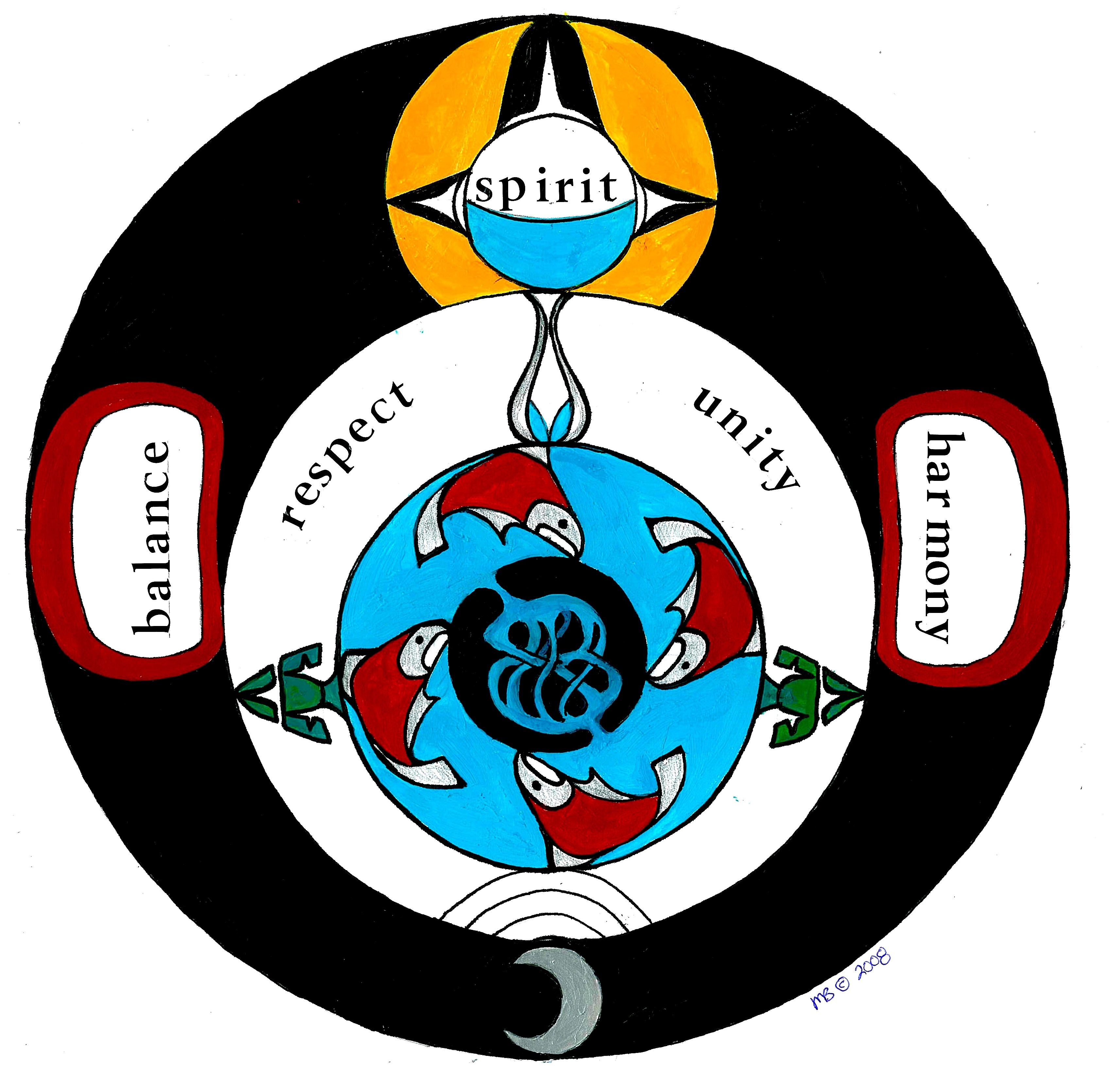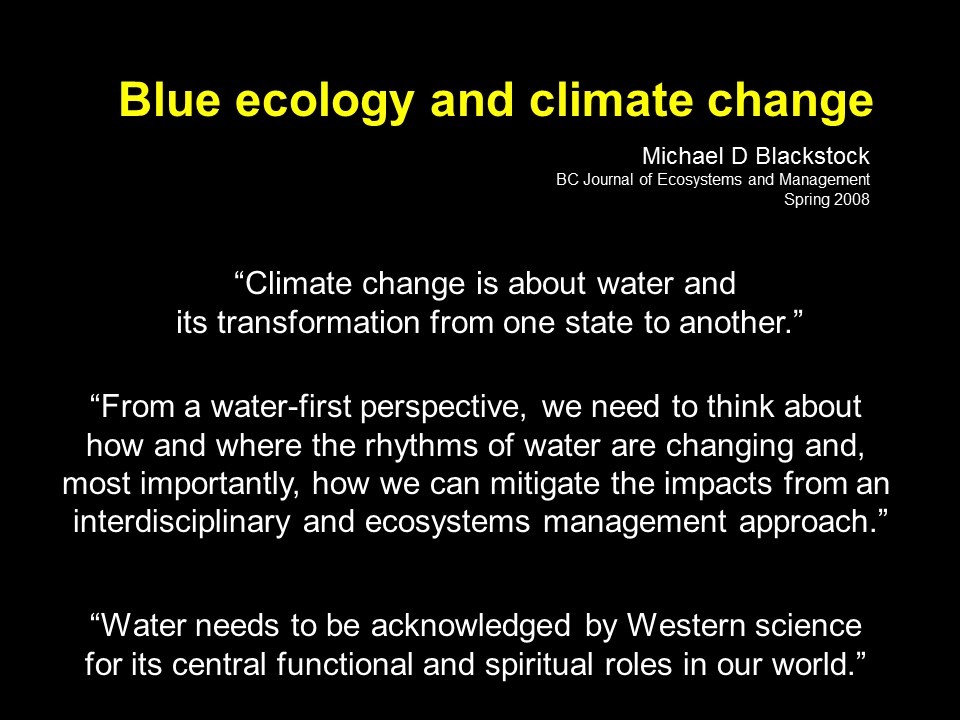“Blue Ecology and climate change: interweaving cultural perspectives on water” – by Michael D Blackstock, independent scholar
Note to Reader:
Work by Michael D. Blackstock in pioneering the concept of BLUE ECOLOGY is a source of inspiration for program development for the Flow and Grow Workshop (November 2016), a joint initiative of the Partnership for Water Sustainability and the Irrigation Industry Association of BC (IIABC).
Blue Ecology – A Vision for Interweaving Two Ways of Knowing
“Cultural knowledge cycles, accumulates, and shape-shifts through generations, just as water, the transitory element, cycles through the oceans, land and sky. Just as the mighty rivers of the world are the sum of the mountains’ trickles, streams, creeks, other rivers and lakes, so too, our global understanding of water can be the joining of diverse cultural streams of thought and perspectives on water management,” wrote Michael D.  Blackstock in the opening paragraph of a peer-reviewed article published (2009) by the International Association of Hydrological Sciences in a conference proceedings.
Blackstock in the opening paragraph of a peer-reviewed article published (2009) by the International Association of Hydrological Sciences in a conference proceedings.
“As the rivers of human knowledge flow across the world’s landscapes, a diversity of cultural tributaries interweave, streaming with their own enhancing qualities of clarity, flow, and experiences. Each stream has its own history, flavour and voice, and yet it has the potential to form a larger whole.”
Michael D. Blackstock is an independent scholar, professional forester and chartered mediator of European and Gitxsan descent. Currently, he is Negotiator/Project Engagement Lead at BC Hydro.
In the beginning….
“When I wrote a book titled The Faces of the Forest: First Nations Art Created on Living Trees, the water theme kept coming up during my interviews of First Nations elders. It was then that I decided to chase down the path that soon led me to the concept for Blue Ecology,” recalls Michael D. Blackstock.
“In 2001, I published my first article to introduce the concept of interweaving. At that time I described it as water-based ecology. In 2005, I replaced ‘water-based’ with ‘blue’. It was the paper that I wrote for the BC Journal of Ecosystems and Management that branded Blue Ecology.”
“In 2008, I was appointed to a UNESCO Expert Panel for a 4-year term. That led to my participation as a speaker at a conference organized that same year by the International Association of Hydrological Sciences. Held in Capri, the conference introduced Blue Ecology into mainstream science and resulted in fast-track inclusion of my paper in a peer-reviewed publication.”
“Looking back, this audience of scientists has been the most receptive to my concept for interweaving Western science and the First Nations spiritual perspective. They got it.”
“Interweaving is a tool for bringing perspectives together. Western science is not wrong. It is just not complete. It is a matter of Western science embracing that water is part of a living ecosystem. The peer review by the International Association of Hydrological Sciences has given Blue Ecology credibility,” concludes Michael D. Blackstock.
Alignment with a Water Balance
way-of-thinking and acting
“Blue Ecology aligns with the natural systems approach to Water Balance management that the Partnership for Water Sustainability champions,” states Kim Stephens, Partnership Executive Director.
 “The Water Balance of watersheds in urban areas is out of balance. A legacy of past community planning and infrastructure servicing practices failed to protect the natural Water Balance. A watershed is an integrated system. Restoring hydrologic integrity, and thus the Water Balance, is the pathway to a water-resilient future. Communities would make a difference over time if water and land professionals heeded and applied the messages in Blue Ecology.”
“The Water Balance of watersheds in urban areas is out of balance. A legacy of past community planning and infrastructure servicing practices failed to protect the natural Water Balance. A watershed is an integrated system. Restoring hydrologic integrity, and thus the Water Balance, is the pathway to a water-resilient future. Communities would make a difference over time if water and land professionals heeded and applied the messages in Blue Ecology.”
In the words of Michael D. Blackstock:
Hydrologists are encouraged to embrace the companion Blue Ecology water cycle that is meant to enhance Western science’s hydrological cycle by providing a holistic cultural context. Hydrologists and water managers could also communicate complex climate change impacts to the public, using common sense terms. Hydrologists and water managers can use the hydrological and Blue Ecology cycles to help explain how and why the climate is changing…..
Water is a core human interest upon which we can build collaborative cross-cultural climate change strategies……There is hope for future generations if we take a water-first approach to setting global priorities.
To Learn More:
Download Blue Ecology and climate change: interweaving cultural perspectives on water, an indigenous case study, published in The Role of Hydrology in Water Resources Management (Proceedings of a symposium held on the island of Capri, Italy, October 2008) by the International Association of Hydrological Sciences, 2009.

Blue Ecology water cycle and principles, designed by Michael D. Blackstock as a companion to the conventional science-based Water Cycle


